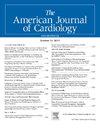Prospective Comparison of Temporal Myocardial Function in Men Versus Women After Anterior ST-Elevation Myocardial Infarction With Timely Reperfusion
IF 2.3
3区 医学
Q2 CARDIAC & CARDIOVASCULAR SYSTEMS
引用次数: 0
Abstract
Compared to men, women have been reported to have increased morbidity and mortality after ST-elevation myocardial infarction (STEMI); but sex differences in cardiac function in the acute and subacute phases of STEMI are incompletely understood. The objective of this study was to prospectively compare changes in cardiac function over the acute and subacute phases after anterior STEMI with timely reperfusion in women versus men. The Stunning in Takotsubo versus Acute Myocardial Infarction (STAMI) study (NCT04448639) prospectively enrolled 105 men and 41 women with anterior STEMI. Echocardiography and blood sampling were performed within 4 hours of admission and at 1, 2, 3, 7, 14, and 30 days after admission. The primary outcome was akinesia recovery, defined as the difference in the percentage of akinesia observed at baseline versus follow-up. Secondary outcomes included wall motion score index (WMSI), left ventricular ejection fraction (LVEF) and global longitudinal strain (GLS). Mixed effects linear regression or zero-inflated tobit models with random intercepts were used to model echocardiographic parameters over time. Baseline patient characteristics were similar in both groups. The difference between women and men in akinesia recovery at 30 days was 8.3% (95% credible interval 0.8%, 15.5%). The covariate-adjusted posterior probability that akinesia recovery and WMSI improvement at 30 days are greater in women than men were 96.0% and 99.0% respectively. Similar but less pronounced trends towards greater improvement in women than men were observed for LVEF and GLS. In conclusion, cardiac dysfunction recovered to a greater extent in women than in men after anterior STEMI with timely reperfusion.
求助全文
约1分钟内获得全文
求助全文
来源期刊

American Journal of Cardiology
医学-心血管系统
CiteScore
4.00
自引率
3.60%
发文量
698
审稿时长
33 days
期刊介绍:
Published 24 times a year, The American Journal of Cardiology® is an independent journal designed for cardiovascular disease specialists and internists with a subspecialty in cardiology throughout the world. AJC is an independent, scientific, peer-reviewed journal of original articles that focus on the practical, clinical approach to the diagnosis and treatment of cardiovascular disease. AJC has one of the fastest acceptance to publication times in Cardiology. Features report on systemic hypertension, methodology, drugs, pacing, arrhythmia, preventive cardiology, congestive heart failure, valvular heart disease, congenital heart disease, and cardiomyopathy. Also included are editorials, readers'' comments, and symposia.
 求助内容:
求助内容: 应助结果提醒方式:
应助结果提醒方式:


